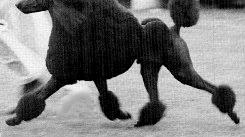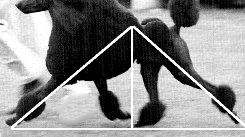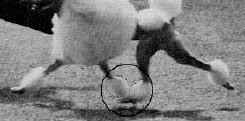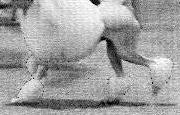


|
GAIT / MOVEMENT |
|
|
|
Discussion Notes: |
|
1.
Correct conformation will ensure the movement is "sound
and free". The Poodle does not single track. The dog
must move in a straight line, showing no signs of
"crabbing". |
|
Viewed coming towards you, the feet move parallel to each
other (as illustrated in Figure A) with elbows close to the
body and the feet turning neither in nor out. Viewed from
behind, the hind feet move parallel to each other (as
illustrated in Figure B). |
If the dog is gaited very quickly the feet will tend to move slightly closer to each other to maintain centre of balance but the legs themselves will remain straight (as illustrated in Figures C and D). This is normal and correct. This tendency for the feet to move closer together occurs as the speed of the gait is increased and it should not be confused with "moving close" where both legs are vertical and very close together, a result of incorrect ribcage shape. There should be no evidence of "plaiting" (crossing over) |
|
||||
|
In profile, the forelegs have good reach because of the well laid back shoulders and there should be a strong driving rear action (as illustrated in Figures E and F). |
 |
||||
 |
|||||
|
Because of the conformation of the hind legs, the dog is able to bring the hind legs well under the body thus providing the necessary thrust in its action; the Poodle should not over-reach (as illustrated in Figure G). |
 |
||||
|
Excessive motion wastes energy and shortens stride; actions such as a high hackney knee action or paddling are faulty (as illustrated in Figure H) |
 |